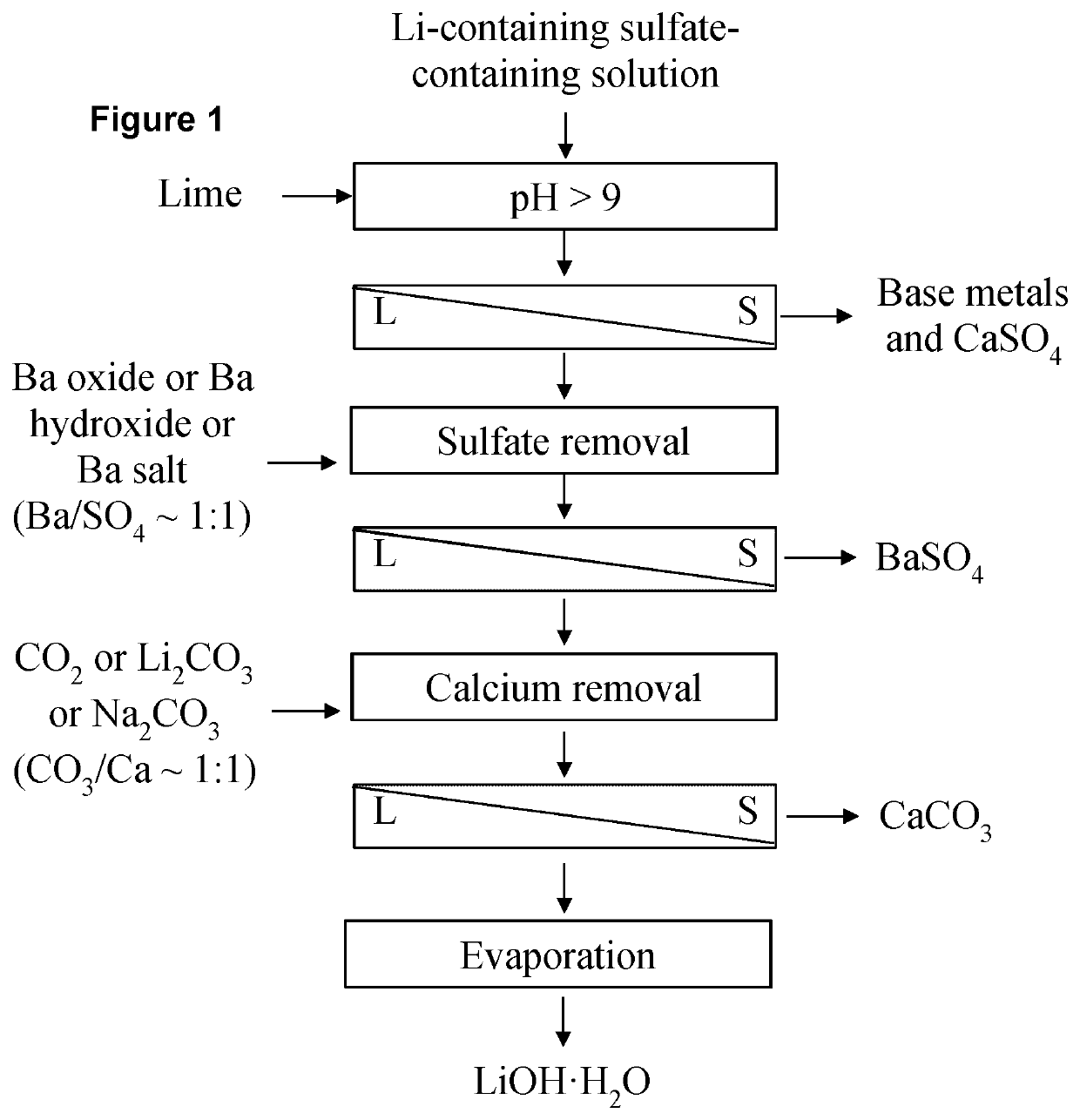Lithium recovery and purification
a lithium and purification technology, applied in the field of lithium recovery and purification, can solve the problems of scale and cost, efficiency, and purity obtained level
- Summary
- Abstract
- Description
- Claims
- Application Information
AI Technical Summary
Benefits of technology
Problems solved by technology
Method used
Image
Examples
example 1
urification Procedure—Direct Lithium Hydroxide Test 1
[0084]The following Stages 1-5 describe the preparation of a model synthetic solution of a mixture of metal sulphates and the subsequent recovery of Li in the form of LiOH.H2O. Analysis of samples and results are shown in Table 1.
Stage 1—Preparation of Synthetic Solution
[0085]1. The following were combined in a 2 L leach kettle:[0086]a. 500 mL of de-ionized water[0087]b. 50.7 g Li2SO4.H2O[0088]c. 680 mg of CaSO4 (anhydrous)[0089]d. 725 mg of Na2SO4 (anhydrous)[0090]e. 200 mg of MgSO4 (anhydrous)[0091]f. 1450 mg of K2SO4 [0092]2. Mixed at 350 to 400 rpm at 25° C.[0093]3. Sample of the solution was taken for chemical analysis, and verified that all solids are dissolved.
Stage 2—Sulphate Removal 1
[0094]4. At room temperature, solid Ca(OH)2 was added to raise the pH of the filtrate from Stage 1 to pH 11. The total amount of Ca(OH)2 added to the solution was recorded, so that the Ca concentration in the solution can be calculated. Held ...
example 3
f Various Parameters on Lithium Recovery
[0119]This study investigates the conditions for: (a) recovery of lithium with various concentrate of Ba (Ba / SO4 molar ratio: 80-120%), Na (0-30 g / L), Li (5-15 g / L); (b) pH from 6 to 10; (c) temperature from 5-60° C., time from 0-120 min.
[0120]Ba(OH)2 or BaO was first dissolved in to 50 ml distilled water to make Ba(OH)2 slurry. Then, the slurry was added to 100 ml of Li2SO4 solution, drop by drop (10 ml slurry / 10 min), and further reacted for 2 hours, followed by filtration. Taking one sample every 50 min.
[0121]FIG. 2 further shows regeneration of Ba(OH)2 and H2SO4. As can be seen, BaSO4 obtained after Stage 3 is calcinated at a temperature between about 600-800° C. BaO and SO3 are formed. BaO is treated with water yielding Ba(OH)2 which is recycled for use in the process at Stage 3. SO3 is also treated with water, yielding H2SO4 which is recycled for use to regenerate metal sulphates (including Li2SO4).
[0122]The conditions of the various exp...
example 4
Removal from Li PLS
[0123]A lithium containing material, which was processed to become amenable to sulfuric acid leaching, was leached in sulfuric acid solution with a final pH of about 2.5. The pregnant leach solution (PLS) had 11 g / L lithium, 2.7 g / L aluminum, 300 mg / L iron, and other impurities.
[0124]If iron and other cations are in the reduced form then the PLS can be oxygenated or the potential of PLS can be increased by oxygen or other oxidants to oxidize species to more oxidized forms, prior to impurity removal with pH adjustment as oxide and / or hydroxide forms. Alternatively, the PLS can be processed without the oxygenation or oxidation process.
[0125]In this example (Example 4) in a series of tests (see Table 4) lime was used as the alkaline material to increase the pH to 3.0 to 6.0 range and remove part of the impurities, mostly including Fe and Al. The process can be carried out in a wide temperature range of ambient T to near boiling temperature. At ambient temperature, in...
PUM
| Property | Measurement | Unit |
|---|---|---|
| Temperature | aaaaa | aaaaa |
| Temperature | aaaaa | aaaaa |
| Temperature | aaaaa | aaaaa |
Abstract
Description
Claims
Application Information
 Login to View More
Login to View More - R&D
- Intellectual Property
- Life Sciences
- Materials
- Tech Scout
- Unparalleled Data Quality
- Higher Quality Content
- 60% Fewer Hallucinations
Browse by: Latest US Patents, China's latest patents, Technical Efficacy Thesaurus, Application Domain, Technology Topic, Popular Technical Reports.
© 2025 PatSnap. All rights reserved.Legal|Privacy policy|Modern Slavery Act Transparency Statement|Sitemap|About US| Contact US: help@patsnap.com



